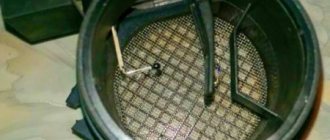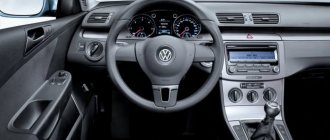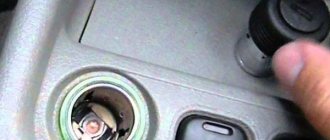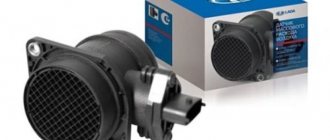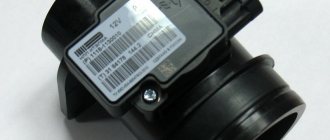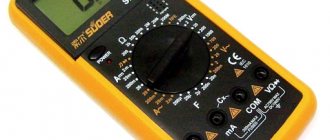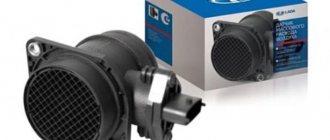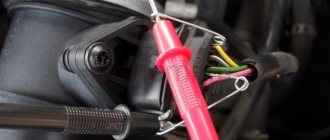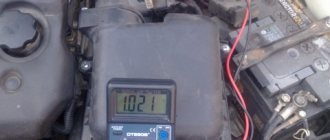Compound
Designed to effectively remove oil, dirt, small fabric fibers and dust from the sensor without damaging it. The main components of MAF sensor cleaners are:
- Hexane, or its rapidly evaporating derivatives.
- An alcohol-based solvent (usually 91 percent isopropyl alcohol).
- Special additives that manufacturers (the main one is the Liqui Moly trademark) use to protect their copyrights. They mainly affect smell and density.
- Carbon dioxide as a retardant for the composition in a can.
The mixture is usually sold in the form of an aerosol, so the substances must be highly dispersed, not irritate the skin and not have a harmful effect on the environment. The physical and mechanical characteristics of the most commonly used compounds (for example, Luftmassensensor-Reiniger from Liqui Moli) are:
- Density, kg/m 3 - 680...720.
- Acid number – 27…29.
- Ignition temperature, º C – not less than 250.
Types and design of sensors
The mass air flow sensor is a complex element of an injection engine. It consists of a sensor module and a tube-shaped housing. On imported air flow devices the grille is metal, while on Russian analogues it is plastic. The dimensions of all sensors are identical; there is a screw for adjusting the carbon dioxide level.
The difference between the sensors is that some of them are touch sensors, others are film ones.
Flow meter designs have changed over the years. In recent years, the most popular in the automotive markets has become the following: a sensor based on a heated wire and a flow meter on a vane damper.
The sensitive element located in the pipe consists of 2 thin platinum threads. When the ignition is turned on, electric current is transmitted to these threads. The current exposes the platinum filaments to heat. The air entering through the air intake cools them and changes the resistance. These signals are monitored by the motor control unit, which increases or decreases air flow.
Removing the sensor
The positive aspect of this type of sensor is that it quickly responds to changes in air flow, measures the mass of air passed through, and does not interfere with its flow.
This type of flowmeter has a sensing element in the form of a damper in the intake manifold. The resistance is measured by a built-in potentiometer in proportion to the angle of rotation of the damper. Such sensors have a manual setting that helps to lean or enrich the mixture depending on the temperature of the region and time of year. This device restricts air flow, reducing engine power.
There are also modern alternatives: mass flow sensor based on “cold wire” and a membrane flow meter.
In this type of sensor, when air flows pass, self-induction of the sensitive element occurs. It is measured. The basis for the creation of the flow meter was the theory of one of the physicists about vortex shedding. The measurement of the vortex shedding frequency is in accordance with the air flow speed.
The membrane air flow sensor is based on a working membrane placed in the air flow. The control unit evaluates the temperature difference between the sides of the membrane, which are cooled unevenly.
Most often, sensors become unusable due to high mileage of the car or its operation in difficult conditions.
How to use?
Cleaning the air flow sensor must be performed whenever the air filters are changed. The sensor itself is located in the air channel between the filter box and the throttle body. Using a special tool, the device is carefully disconnected from the electrical connectors.
Some brands of cars are equipped with mechanical flow meters. They do not have measuring wires, and therefore are less sensitive to the thoroughness of dismantling.
Next, 10 to 15 sprays are applied onto the wire or sensor plate. The composition is applied to all sides of the sensor, including terminals and connectors. Platinum wires are very thin, so they cannot be wiped. After the composition has completely dried, the device can be returned to its original place. A good spray should not leave marks or streaks on the surface of the air flow sensor.
Installation and dismantling of the mass air flow sensor
Removing the mass air flow sensor from the Priora along with the sensor housing
Removing a sensor that has failed is carried out in the following sequence:
- Turn off the ignition.
- Disconnect the sensor by removing the chip from it, using a screwdriver you need to loosen the ring (clamp).
- Unscrew the screws with a key “8” and remove the flow meter.
- Disconnect the sensor from the air filter and remove it.
The sensor itself cannot be repaired, so it is usually replaced with a new one. The only thing that can be done if problems arise in the engine due to incorrect operation of the flow meter is to clean the mass air flow sensor. How to do this correctly will be discussed below.
Installation of the mass air flow sensor is performed as follows:
- A sealing sleeve is placed on the sensor.
- The sensor is mounted on the air filter, to which it is attached using two bolts.
- The inlet hose is connected to the sensor and clamped with a clamp.
- A block with wires is connected to the sensor.
After installation, you need to start the engine and check its operation, first when it is cold, and then when it warms up. The revolutions should be smooth, and when testing with specialized equipment, the mass fuel consumption should be within normal limits. You can see the readings by connecting the scanner to the ECU:
- 10 kg per hour (±0.5 kg in both directions) - at 800 - 1000 rpm;
- 19-21 kg per hour - at 2000 rpm.
It is important to remember that if the sealing sleeve is not in place
is fraught with interruptions in the operation of the motor, so it must be installed.
Do not leave foreign objects in the sensor
, since this threatens to damage it, leading to disruptions in the functioning of the engine ECU.
Removal and reinstallation of the sensor sensing element is prohibited
, since this entails an inevitable change in its characteristics.
Features of application
The nuances are determined by the brand of car that has a mass air flow sensor. In particular, the choice of installation tools used to unscrew the fasteners depends on this.
You should never use MAF cleaner while the engine is running or the ignition is on. This can cause serious damage to the sensor, so it should only be disconnected when there is no current in the system.
Before spraying, place the sensor on a clean towel. Cleaning must be done so as not to touch any of the sensitive elements with the nozzle of the aerosol head.
To improve the cleaning effect, it is recommended to pre-wash the surface of the air flow sensor. To do this, place the unit in a plastic bag filled with isopropyl alcohol and shake vigorously several times. After drying, apply mass air flow sensor cleaner.
Step-by-step process
Purchase the required liquid, take a disposable syringe and a flat-head screwdriver. Even if you are a pro and know every crack of your car, still read the instructions again on how to clean the mass air flow sensor on a VAZ 2114. If you opened the hood of your fourteenth for the first time and you feel itchy, pray that everything goes smoothly, while reading the instructions at the same time.
- We opened the hood, found the sensor, removed it (loosen the fastening of the air filter hose with the sensor, unscrew the two nuts with a ten-socket wrench and voila, done);
- There is a part on the sensor that is screwed to its body with two bolts; it must be unscrewed;
- Inside, we spray the necessary liquid from a syringe onto the sensitive element (you can also rinse the contact system of the block);
- Let it dry.
All that remains is to put everything back in place and start the engine.
Is it possible to clean the air flow sensor with carburetor cleaner?
It is not recommended to use carburetor cleaners for electronic sensors! The chemicals contained in these products can cause irreversible damage to sensitive elements. However, the use of such compositions for cleaning mechanical flow meters is not excluded. However, here too it is better to use specialized substances, for example, budget cleaners offered by the Kerry brand.
It is necessary to warn owners of cars equipped with similar sensors against other errors:
- Cleaning with more active solvents: this may cause deformation of the plastic parts of the sensor itself and its housing.
- Using cleaner brands not recommended by the vehicle manufacturer.
- Cleaning the mass air flow sensor with products that are used to clean the throttle body.
- Reinstall the unit that has not dried after treatment.
A clean sensor can restore 4 to 10 horsepower to the car, which is well worth the time and expense of cleaning. It is recommended to perform such prevention once a year.
When the first signs of a malfunction occur, you should definitely check the mass air flow sensor, and then, depending on the situation, clean or replace the device.
Examination
Now let's talk about how to check our sensor. Today, two main methods of checking the mass air flow sensor are used.
- The engine is tested in operation with the mass air flow sensor disconnected. Simply turn off the power from the regulator and start the motor. When the mass air flow sensor is not present during startup, the electronic control unit turns on the power unit in emergency mode. The speed is adjusted to 1500 rpm. After disconnecting the sensor, drive a few kilometers and evaluate the dynamics and power. If the engine is running normally, then the sensor is the cause of the symptoms.
How to check for a faulty air flow sensor?
The parameters transmitted by the mass air flow sensor play a large role in the balanced formation of the combustible mixture. Accordingly, breakdowns associated with the operation of the air sensor can lead to disruption of the functionality of the system as a whole. In some cases, incorrect operation of the sensor may make it impossible to start the engine.
Let's look at the signs by which you can determine if the mass air flow sensor has failed:
- the Check Engine light comes on on the dashboard;
- increased fuel consumption;
- decrease in the level of power and traction of the car;
- decrease in dynamics with increasing car speed;
- Difficulty starting the engine or the impossibility of starting it at all;
- in idling mode, the unit speed will float.
Design and designation of mass air flow sensor elements
Of course, such malfunctions speak not only of, but also of other breakdowns. Therefore, a car enthusiast should know how to correctly determine the incorrect operation of the regulator. To carry out diagnostics, there are several options, the simplest of which is to turn off the power from the mass air flow sensor while the engine is running.
After the power is turned off, the machine control unit begins to operate in emergency mode; in this case, the dosage of gasoline, diesel or gas is carried out according to the readings received from the throttle. Note that in this case the idle speed may begin to increase to 1500, but in some injection engines the speed does not increase. When the mass air flow sensor is disabled, you need to drive the car. If engine performance has improved, the mass air flow sensor will need to be replaced or cleaned.
Cleaning
Quite often you can avoid replacing the mass air flow sensor by simply cleaning this engine element.
You should do the cleaning yourself in this way:
- Remove the pipe from the mass air flow sensor;
- Now remove the sensor from the pipe. Otherwise, high-quality washing will not work;
- To remove the sensor, arm yourself with sprocket keys in advance. Finding such kits is not a problem;
- Unscrew all the fasteners, remove the sensor from the pipe and assess its external condition;
- Often there are traces of oil deposits on the sensor. The purpose of cleaning is to make the device as good as new;
- Carburetor cleaner is often used to clean the air flow sensor;
- Inside the film there are sensors, which are small wires attached to a special resin. These elements must be carefully sprayed with cleaner so as not to damage the devices;
- Wait a while for the surfaces to dry. To speed up the process, use a can of compressed air;
- It is not uncommon to use alcohol instead of carburetor cleaner, which also works quite effectively;
- Proper cleaning of the mass air flow sensor involves treating the pipes from accumulated debris, dirt and dust;
- Having carefully processed all the components of the removed mass air flow sensor, wait until it dries, and then reassemble it. Cleaning is complete.
Spray cleaning
Statistics show that in about 80% of cases, simple cleaning can return the mass air flow sensor to its previous functionality.
Price issue
80% is not 100. Therefore, sometimes you have to change the sensor. And to replace it, you need to buy it.
There are three price categories for air mass flow sensors:
- Cheap. These are predominantly Chinese products, the price of which is up to 1000 rubles. It is strongly not recommended to purchase such regulators;
- Average. These include sensors from AvtoVAZ, domestic and some foreign analogues. These cost from 1500 to 2500 rubles;
- Expensive. High-quality, reliable, imported air flow sensors, the price of which can reach 5.5 thousand rubles. It’s hard to say how rational it is to buy them. But they will definitely last a long time.
When choosing a new mass air flow sensor, focus not only on the price, but also on the manufacturer. Today, the most popular devices are from Siemens and Bosch. Average in price, excellent in quality.
How to clean the mass air flow sensor
Replacing the clutch on a VAZ 2110 with your own hands
Before you begin, here are a few notes to be aware of:
- Some manufacturers recommend replacing the MAF rather than cleaning it if the hot wire or sensing elements are dirty because cleaning the wires will not restore the sensor to its original performance. However, cleaning a dirty MAF sensor may work fine in most cases.
- If your sensor is around 100,000 miles or more, you may want to consider a new replacement, especially if engine performance seems a little sluggish after cleaning.
Unlock the tab to disconnect the MAF electrical connector.
Now, if you are ready to start, make sure the ignition switch is in the "Off" position. Then set the parking brakes and open the hood.
- Disconnect the MAF electrical connector. Be careful. You may have to press down on a plastic tab or latch to release the connector.
- Remove the bolts, usually two, that hold the sensor in place. On some models it is located inside the air filter box. If necessary, consult your vehicle's repair manual.
- Remove the sensor from the air intake trunk lid or air filter box.
- Check the rubber gasket that seals the MAF to its housing. If damaged, replace it.
- Do a visual inspection. Check the sensor for overheating and, if installed, cold wires for traces of dust, dirt, debris or insects.
- Place the MAF on a workbench or similar surface and leave it on the rag. The rag will help you catch the cleaning solution runoff as you spray the sensor.
- Wear safety glasses and latex gloves.
- Clean the sensor by spraying it with cleaning solution. Follow the instructions included with your product. Whatever you do, avoid touching sensitive wires. They are fragile and can break easily.
- If the hot and cold wires are covered in dirt or debris, you can use a brush to wipe them off.
- Spray a small amount of sensor cleaning solution into a small, clean cup.
- Soak a small brush in the cleaning solution.
- Use a brush to remove dirt and debris from the wire(s).
- After cleaning the MAF, allow it to dry completely for a few minutes.
- Meanwhile, remove dust and debris from the air filter housing and air ducts. If there is dirt or debris in the ducts, the unit forces air through the air filter.
- Install the air filter correctly and close the air filter box and air duct.
- Install the MAF, make sure the rubber seal is installed correctly, and secure the sensor with the mounting bolts.
- Connect the MAF electrical connector. Make sure the tab is locked.
- If necessary, clear fault codes using a scan tool.
- Start the engine and listen to it at idle speed.
Depending on your specific model and the trouble codes set in your computer's diagnostic memory, you may need to drive several miles to improve engine performance. For example, you may still notice a rough idle. The ECM (Engine Control Module) may take some time to adjust to the new input parameters.
If cleaning does not solve your engine's performance problems and you suspect a problem with the sensor, you may want to check the MAF sensor or replace it.
A couple of recommendations:
- If you find dirt or debris attached to the wires or sensing elements, this may indicate a faulty self-cleaning circuit. You can test the "off" relay and, if necessary, the circuit. Refer to your vehicle's repair manual.
- Some manufacturers recommend replacing the air filter after cleaning the MAF.
Securely secure the clamps of the air filter assembly to prevent air leakage.
Replacement
It is not difficult to replace the mass air flow sensor with your own hands, even if you do not have any special skills in car repair. Having checked the condition of the device and determined that cleaning will not help, all that remains is to replace it.
- Place the car on a level surface, lift the hood and remove the negative terminal from the battery.
- Disconnect the sensor connector. We have already talked about its location, so there will be no problems with the search.
- Using a screwdriver, remove the clamping bolt of the clamp that secures the corrugation to the mass air flow sensor.
- The corrugation is removed.
- Using a 10mm wrench, unscrew the two bolts that hold the sensor to the air filter housing.
- After removing the failed oxygen sensor, install a new regulator in its place.
- Screw back a couple of bolts, secure the corrugation and secure it with a clamp.
- Reconnect the connector and return the negative terminal to the battery.
If everything is done correctly and the breakdown is correctly identified, then the engine will return to its previous performance and the error signal on the dashboard will disappear.
Replacing the device
To finally check the result of the repair, go out onto the road, do a test drive and be sure to try to press the gas pedal sharply. If the dynamics and power become the same as before the problems arose, you did everything correctly, and it was the mass air flow sensor that was the culprit of the malfunction.
Every vehicle owner who takes good care of his car and is interested in it knows very well what a mass air flow sensor, or MAF, is. Also, many car enthusiasts know what functions this device performs. At the same time, not every driver knows how to clean the mass air flow sensor. What exactly is this detail and what is its role? This question is relevant for many beginners.
What is a mass air flow sensor, why is it important and how to diagnose its malfunction
Over the past three decades, engines with distributed and direct fuel injection have finally supplanted all other types of designs. It would seem that this is a considerable period of time, but engineers have not been able to overcome the “childhood diseases” of important electronic components, including the mass air flow sensor (MAF), which is responsible for the composition of the air-fuel mixture. Let's remember how the mass air flow sensor works, why it is so important and how to diagnose its malfunction.
What is DMRV
Modern engines use two types of power supply systems: with distributed injection, the nozzle supplies fuel to the intake pipe, with direct injection, it supplies fuel to the combustion chamber. For both systems, the correct operation of the mass air flow sensor, which was once mechanical (vane type), but is now devoid of moving mechanical parts and made hot-wire (from “anemo” - wind), is important.
Factory air flow sensor made in Germany for a VAZ engine
The mass air flow sensor can be installed not only on a gasoline engine, but also on a diesel engine, where the operation of the EGR valve (exhaust gas recirculation system) is “tied” to it.
As old-school drivers used to say, an internal combustion engine does not work in two cases: there is nothing to burn or there is nothing to set it on fire. The mass air flow sensor precisely informs the electronic control unit about the amount of incoming air, the oxygen of which becomes the “fuel” for the working mixture. Having received such a signal, the ECU can ensure the most complete combustion possible. The device, located in the intake tract, consists of two resistors, which can be designed in various designs. In the first case, the resistor is exposed to passing air: when the flow intensity changes, it cools and its internal resistance changes. In the second case, it is not blown - based on the difference in readings from two resistors, the volume of air that needs to be supplied to the cylinders is calculated.
The sensor is supplied to the aftermarket with protective caps to prevent contamination during transportation.
This is what the sensor looks like on a regular VAZ engine. It will not be possible to remove it from the case without a special key.
The removed sensor is in its “bare” state. The sensitive element is clearly visible
Based on the data on the mass and temperature of the incoming air, the ECU determines its density, and also calculates the duration of opening of the injectors and the amount of fuel supplied to the combustion chamber. In general, the mass air flow sensor is important for achieving maximum engine power, for more complete combustion (environmentally friendly), and for economical driving. The failure of this sensor, like most others, causes the Check Engine warning light to go off.
The check engine light can come on for any reason. If there is no on-board computer with a diagnostic function, you will have to go to a service station where there is a scanner
However, the owner does not always associate the triggered “check” with the mass air flow sensor - especially if the engine runs without any interruptions, and the dynamic characteristics of the car have not deteriorated at all. Therefore, it is important not to leave the illuminated engine malfunction indicator unattended, but to consider errors with the diagnostic computer.
MAF or DBP?
The absolute pressure sensor (MAP), together with the temperature sensor (DTS), also controls how much air enters the intake manifold. Based on these readings, the controller generates a pulse command to the injectors. An important difference between DBP and MAF is the absence of air in the housing, since this sensor works based on measuring the difference in inlet pressure and pressure in the vacuum chamber. A design feature of the DBP is a highly sensitive diaphragm, which expands under the influence of pressure in the intake manifold. This process affects the resistance of the strain gauges, as a result of which the voltage changes.
The absolute pressure sensor (pictured) and the mass air flow sensor operate on different principles
DBP is much cheaper than a mass air flow sensor, but its operating algorithm is less advanced. And in general, not all control units can work correctly with DBP. Moreover, when switching to an absolute pressure sensor, the engine may respond to opening the throttle with a much greater delay than with the original mass air flow sensor. And, of course, simply replacing the mass air flow sensor with a DBP without serious modifications will not work due to the difference in their design and even location.
There are engines where there is no choice between DBP and MAF, because both of these sensors are present on the engine at once!
Usually, thoughts about installing a DBP instead of a standard mass air flow sensor appear when the latter fails, as well as during engine tuning - especially if the aspirated system is converted to turbocharging. However, some owners deliberately refuse the mass air flow sensor because of its high cost and not the greatest resource. Indeed, in an unfortunate combination of circumstances, the sensor can fail after 60-70 thousand kilometers, and by the figure of 120-130 thousand on the odometer of many budget cars, it is almost guaranteed to “die”.
When is it time to clean?
But regardless of the type of sensor, over time it begins to function incorrectly due to contamination - the platinum measuring elements become covered with dust. Therefore, the question of how to clean the mass air flow sensor will always be relevant.
Why does this happen? The main reason for sensor contamination lies on the surface - the unsatisfactory condition of the air filter. If the filter element is of poor build quality, then it is not able to trap microscopic particles of dirt and dust that settle on the sensing element of the mass flow sensor.
As a result, the device is not able to accurately measure the amount of air and sends incorrect data to the ECU. It's not hard to imagine what this might lead to. Here we gradually approach some characteristic signs that may indicate that the sensor is clogged and needs to be cleaned:
- The need to clean the mass air flow sensor on a VAZ or other cars arises when the engine idles intermittently, in some cases they are too high - up to 1500.
- The car may jerk and have difficulty accelerating.
- Sometimes the engine does not start at all.
- Increased fuel consumption - sometimes up to 15 liters per 10 km.
- Check Engine light on the dashboard.
However, the above signs do not always accurately indicate contamination of the air flow sensor. A variety of situations can arise, and among them is one when the sensor itself is fine, but the fault lies in the hose that connects the device to the module.
In other words, although there are many obvious signs that a particular part of the car is faulty, they can indicate any other problem.
Cleaning the sensor yourself
How to clean the air flow sensor at home?
The process is considered using the example of a VAZ 2110 car:
- Turn off the ignition and disconnect the connector from the regulator. It is necessary to dismantle the pipe; to do this, use a wrench to unscrew the bolt or two bolts securing the mass air flow sensor to the air filter housing. The principle of turning off the regulator may vary depending on the car model.
- The regulator must be removed from the hose, otherwise flushing the mass air flow sensor will be ineffective. To dismantle the device from a VAZ car, you will need an asterisk key of the appropriate size. You will need to unscrew the screws, after which you can remove the regulator.
- It happens that there is an oil coating on the device, so it is necessary to make everything as clean as possible. To clean the regulator from deposits, you can use carburetor cleaning fluid. You can also use a special Liqui Moly cleaning agent, it all depends on your financial capabilities. But in fact, there is practically no difference between these liquids. On the film located inside, you can see several sensors made in the form of wire; they are fixed using a special resin. Using carburetor cleaner or any other product, carefully spray this sensitive component. Do this carefully so as not to damage the film. Wait a few minutes until the liquid dries and evaporates. Depending on the amount of contamination, the procedure can be repeated several times. To make the product evaporate faster, you can use a compressor or pump. It is important to remember that a lot of pressure is not required for purging; the device just needs to be dried.
To clean it, you can use other options, as already mentioned, it could be alcohol. In addition to the regulator, you can clean the hose mesh and its inner surface. Pay attention to the pipe - if its condition is poor, there are cracks and other signs of damage, it is advisable to replace it.
But that is not all. Reassemble the components in reverse order. Experts recommend replacing the filter element after this procedure. Before installing the mass air flow sensor, check the tightness of the sealing rubber. Please note that if the seal does not fit tightly, this may lead to the suction of outside air, which is not cleared of impurities. This can lead to accelerated failure of the mass air flow sensor.
In fact, the cleaning procedure allows you to restore the functionality of eight out of ten regulators. It’s worth trying to wash the sensor, because the cost of the procedure is usually 10-15 times less than buying a new regulator.
Cleaning the mass air flow sensor is a procedure necessary to ensure reliable engine operation. Some car enthusiasts believe that the MAF (mass air flow sensor) is a part that cannot be serviced and that if it fails, replacement is necessary. However, practice shows that after cleaning, most sensors can continue to work successfully. In addition, this part is quite expensive. Therefore, the ability to maintain the sensor in working condition not only ensures the normal functioning of the car engine, but also allows you to significantly save money.
The mass air flow sensor is designed to measure the amount of air that enters the engine per unit of time. In accordance with its indications, a combustible mixture is formed. Therefore, interruptions in the operation of the mass air flow sensor can lead to serious problems in the functioning of the engine.
Signs of possible problems with the sensor include:
- increased fuel consumption;
- drop in power and decrease in traction;
- deterioration in acceleration dynamics;
- problems starting the engine;
- floating idle speed;
- The Check Engine light on the instrument panel comes on.
The presence of these signs may indicate other problems. Therefore, it is better to conduct additional diagnostics of the air flow sensor.
Sensor diagnostics can be carried out in different ways. The simplest of them is to disconnect the power from it while the motor is running. After this you need to drive a little. If during this time an improvement in engine performance is observed, then the mass air flow sensor is faulty .
To clean the air flow sensor efficiently, you need to choose the appropriate cleaning agent.
The following may be suitable for this procedure:
- Liqui Moly liquid;
- alcohol;
- carburetor cleaning fluid;
- “Liquid Key” product;
- WD-40.
Liqui Moly liquid is the highest quality product that can be used to clean the sensor. But at the same time, it is also the most expensive of cleaning products. Recently, WD-40 has become increasingly popular among car enthusiasts.
Attention! If you decide to clean the sensor with alcohol, do not use vodka or moonshine instead. This may lead to permanent failure of the device.
Cleaning the air flow sensor is not a complicated procedure. It is quite possible to produce it in your garage.
To do this, you should perform the following actions (using the example of the VAZ-2110):
- Turn off the ignition and remove the terminal from the battery.
- Disconnect the connector from the sensor and disconnect the pipe from it.
- Using a wrench, unscrew the screw and remove the sensor from the air filter housing.
- Remove the flow meter from the corrugation.
- Use a cleaning agent to remove oil and dirt from the device.
When cleaning, be aware that the film inside the sensor contains several wire controllers embedded in resin. They should be cleaned with extreme caution.
The cleaning agent must be applied while holding the can at a distance of at least 10 cm from the device. After application, you must wait for the cleaning product to dry.
In cases where the mass air flow sensor is heavily contaminated, it may be necessary to repeat the cleaning procedure several times.
Aerosol composition based on isopropanol with cleaning components. Removes all typical contaminants of the air flow sensor: carbon deposits, oil, dust, etc. It evaporates quickly and does not damage sensors made of any materials: platinum, semiconductor film, etc. — Special composition for cleaning the mass air flow sensor — Safe for all types of sensors, including film sensors — Quickly and effectively removes dirt from the air flow sensor — Evaporates without leaving a residue Using Luftmassensor-Reiniger allows you to economically and easily eliminate the problem of incorrect operation of the air flow sensor, without resorting to expensive replacement.
Application
Remove the electrical connector from the mass air flow sensor and remove the sensor from the engine. Spray the preparation liberally onto the sensitive element of the sensor and allow any remaining contaminants to drain off. Do not touch the sensor elements with your hands or tools. Dry the sensor completely before installation. Recommended for use when regularly replacing the air filter or when problems arise with the engine. Attention: Before use, check for compatibility with plastic on the outer parts of the sensor housing.
The mass air flow sensor (MAF for short) shows how much air is filled in the cylinders when the engine is running. The mass air flow sensor is connected to the electrical harness of the 6-pin block and is located in the space between the air filter and the throttle valve. It is needed to measure the load on the engine and to ensure that fuel is supplied in the required quantity (to monitor this process, you just need to determine the mass of incoming air).
The MAF is of wire (thread) and film type; the fundamental difference is that for the wire type MAF the sensitive element will be a platinum wire, and for the film type there will be a film on which the measuring platinum resistor is attached. Regardless of the type, the mass air flow sensor tends to become dirty (platinum elements become covered with dust and do not work properly). Let's figure out how to clean the mass air flow sensor one by one.
The main reason for contamination of the air flow sensor is the condition of the air filter! If it is not good, then it begins to let in grains of dirt and dust with the air flow, which settle on the sensitive element of the sensor.
Cleaning the air flow sensor is required if:
- At idle the engine runs intermittently,
- The idle speed is unrealistically off the charts,
- When accelerating, it “stutters” (jerks or runs intermittently),
- Benz is consumed in large quantities,
- You basically can't start.
It also happens that the sensitive element itself is fine, but the connection between the sensor and the throttle module is malfunctioning (the connecting hose may crack).
And this is a completely different story. Also, the controller may issue a check engine , which may indicate the same breakdown in the sensor connection circuit (or may indicate a completely different breakdown).
Every owner of a Russian car understands that, despite the obvious signs of a malfunction in a particular part of the car, these signs can relate to any other malfunction. Therefore, trust the signs, but check with specifics.
- Take a multimeter and set it to voltmeter mode;
- We set the measurement limit to 2 V;
- The sensor connector has a yellow wire (the signal is sent to the controller) and a green wire (the signal goes to ground);
- We measure the voltage between these wires: turn on the ignition, but do not start the engine!
- Let's see what the multimeter showed.
We met the limit from 0.99 to 0.02 - good, the sensor is in order; if the upper limit looms around 0.03 - the sensor is a bit old, it is necessary to urgently restore it to normal by cleaning. And if the arrow falls beyond the lower limit (0.95), or sharply exceeds the upper limit (0.05), there are 50/50 chances that flushing the mass flow sensor will help, and it will work like new, or go shopping for a new sensor.
By the way, there is another way to check the working condition of the mass air flow sensor at the fourteenth: disconnect the sensor and start the engine, floor to 2000 rpm, and get going. We drove around and realized that the car had “come to life” - the sensor should be cleaned.
Sensor check
To accurately verify that the sensor is faulty and understand whether the mass air flow sensor on the VAZ-2114 needs to be cleaned or not, whether it needs cleaning or whether you will have to go to the store for a new mass air flow sensor, you will need a multimeter known to all radio amateurs:
- The device is switched to voltage measurement mode (voltmeter).
- Set the limit to 2 V.
- There are two wires in the sensor connector - yellow (it goes to the ECU) and green (connects to ground).
- The voltage is measured between these wires, and only the ignition should be turned on.
- Now all that remains is to look at the instrument readings.
If the measurement result is 0.99-0.02, the sensor is working. If the upper threshold is exceeded to 0.03, the mass air flow sensor needs cleaning and the sooner the better. In the case when the measurements are less than the lower limit (0.95) or the upper limit is very high (0.05), then the chances of a successful outcome are 50/50. That is, either cleaning will help and the sensor will function properly again, or you need to buy a new device.
In addition to this, you can understand whether to clean the mass air flow sensor on a VAZ-2110 or not by using one more method when you don’t have a multimeter at hand. Disconnect the sensor, then start the engine, raise the speed to 2000 and drive for a while. If at this moment there are obvious changes, the car has become more dynamic, then the sensor is definitely dirty.
The main causes of failure of the mass air flow sensor
The most common causes of sensor failure are:
- dust ingress;
- oil contamination;
- short circuit of the wiring due to damage to the insulation or plug;
- mechanical damage to active elements.
A common cause of incorrect operation of the mass air flow sensor is the failure of electronic components, which increases the sensor’s response time to changes in air flow. A working sensor monitors changes at a speed of 0.5 ms, and if it breaks down, the response time increases by 20-30 times. The defect is detected only by recording the operation graph with an oscilloscope. Such a sensor cannot be repaired; it must be replaced with a new one.
What factors disable the mass air flow sensor?
Factors causing failure of the air flow sensor:
- Dust may be caused by improper installation of the sensor on the filter, which causes the sealing ring to become distorted. With this defect, a thin coating of contamination will be present on the sensor input grid. Another cause of dust is a clogged air filter, so regular maintenance will prolong the life of the air flow sensor.
- Oil is thrown onto the sensor if the level in the crankcase is high or if the oil separator in the ventilation system is clogged. An additional negative factor is engine wear, which causes lubricant to actively enter the crankcase ventilation.
- Contact with sharp objects on the insulation, oiling. Such impacts are the result of careless repairs.
- Damage to the sensor is possible during vehicle maintenance (impacts to the body) or during improper cleaning of the active part.
Liqui Moly
How to clean the MAF sensor? One option is cleaning fluid from Liqui Moly. The company is known to many car enthusiasts as a manufacturer that makes only high-quality products for cars. In addition, the ratio between reliability and price is at an optimal level. As for the use of liquid for cleaning the mass air flow sensor, most vehicle owners have already become convinced of its effectiveness. This has not been proven by a single procedure. And if the sensor is in working condition, then even after cleaning it will last no less.
The liquid can be used for both diesel and gasoline engines.
DMRV of VAZ 2115 car
VAZ 2115 cars are the last link in the Samara family and inherited the range of engines from it. Accordingly, the engine ECU controllers and the mass air flow sensors combined with them are similar. Flow meter compatibility is determined by the ECU type, and is as follows:
- ICE VAZ 2111 - Mass air flow sensor 0 280 218 004 (obsolete) or 0 280 218 037, environmental standard Euro 2;
- ICE VAZ 21114 - MAF 0 280 218 116, environmental standard Euro 2;
- ICE VAZ 211183 - Mass air flow sensor 0 280 218 116, environmental standard Euro 3.
Actually, ecology is not related to the type of flow meter; exhaust toxicity is set by the settings of the ECU controller.
Alcohol
We can say that this is an old-fashioned method, which at the same time will never lose its relevance. Alcohol can effectively break down dirt and blockages. About 20 years ago, the question of how to clean the mass air flow sensor was mainly solved with the help of alcohol, and this method was held in high esteem by many drivers, but now they are trying to resort to it less and less.
Nevertheless, it is relevant in cases where the car owner needs to invoice for washing with special means. Unfortunately, such disappointing practice is not uncommon at many service stations.
Causes of malfunctions
In 90% of cases, this is contamination of sensitive sensors.
- a low-quality (not certified) or incorrectly installed air filter allows dust to enter the mass air flow sensor measuring channel;
- when operating the vehicle in wet weather or driving through puddles, droplets of water may enter the intake manifold;
- If the crankcase ventilation system does not work (damaged hoses, broken valve), drops of oil enter the air duct pipe.
A dirty sensor can be cleaned or even washed.
Important! Mechanical impact (brushes, cotton swabs) and the use of aggressive agents (acetone, gasoline) are not allowed.
For small amounts of dirt, blowing with compressed air is sufficient. If the air attack does not help, use a special aerosol cleaner for carburetors and mass air flow sensors.
Before reinstallation, the flowmeter must be allowed to dry in the open air.
Liquid key
This product from a domestic manufacturer is sold in the form of a spray. It is designed to get rid of frozen contaminants on various components and assemblies of vehicles.
Absolutely every car enthusiast is familiar with this product, regardless of experience. In addition, all other people who are not directly related to cars know about it. Over the course of its existence, WD-40 has proven itself to be excellent, and there is no doubt about its effectiveness.
For this reason, it is used not only to remove “deposits” from bolts, but also to clean the mass air flow sensor.
Routine cleaning work
The air flow sensor is cleaned every six months or when changing the oil. Experts also recommend cleaning the device when the air filters are changed. Replacing the sensor at service centers costs $300, but if you clean it regularly, you can avoid car repairs. For this purpose it is recommended to use special means. The MAF cleaner costs about $7. The cheapest option is to take the air flow sensor and place it in a plastic bag filled with alcohol or a special cleaning fluid. Necessary tools for the process:
- 4-in-1 screwdriver;
- digital camera;
- Torx tool;
- MAF cleaner.
After cleaning with cleaning agent or alcohol, allow the device to dry for 20 minutes. Only a completely dry air flow sensor can be installed in a vehicle. Algorithm for cleaning the device:
Before you go to the store for materials and parts, you need to remove the air duct to see how the sensor is attached. If it is held on by Torx screws, then you will need to purchase a Torx tool and a can of cleaner. It is not recommended to use other cleaning agents; they may damage the air flow sensor. Do not use the cleaner with the engine running and the key in the working position. This will cause serious damage to the sensor. With the engine turned off and cooling, disconnect the mass air flow sensor.
Locate the sensor between the air filter box and the throttle body
Before removing the sensor, you should use a digital camera to record settings and connections. Carefully remove the sensor from the air duct and disconnect the electrical connector. Then remove the air intake pipe and mass air flow sensor. Most sensors are connected to hose clamps, so you need to loosen the clamp and remove the device box. Place the air flow sensor on a dry towel. Spray the cleaner onto the inside of the body and the working element 10-15 times. When doing this, you need to be careful not to touch the wires, as they are quite thin. Spray the product onto the entire surface of the air flow sensor, including connectors and terminals. Install the sensor in the car and wait a few minutes before starting the engine until the chemicals evaporate.
Liqui Moly Cleanser
Liqui Moly is a special active solvent for cleaning the air flow sensor for all brands of engines. The cleaner removes contaminants on the hot wire or air flow sensor plate. Suitable for use in gasoline and diesel engines. The cleaning procedure is simple: you need to disconnect the electrical connection of the air flow sensor and remove it by spraying the solution on all dirty areas.
Multi-functional product WD-40
WD-40 is used to wash the sensor and metal surfaces of the car from rust and dirt. The cleaner penetrates boiling deposits, displaces moisture and lubricates almost everything. WD-40 is also great for removing grease, dirt, and other marks from most surfaces. It is an iconic multi-purpose product for general or spot applications.
WD-40 cleans and protects auto tools and mechanical equipment from rust and corrosion, removes grease, dirt, tar, rubber, scratches, water deposits, etc. It is able to penetrate deep into deposits, loosen rusty parts such as nuts, bolts , valves, locks, etc. WD-40 binds and displaces moisture from engines, spark plugs, power tools and vehicle fuel systems.
GDI fuel injector cleaner
Get Clean is a comprehensive cleaning fluid for engine and air sensors. The product is ideally formulated to restore performance, increase horsepower and torque, improve idling and reduce emissions for improved engine performance. Using this product helps to quickly and easily remove even the hardest deposits on the sensor.
If cleaning the air flow sensor with a cleaning solution does not solve the problem, then:
- The self-cleaning circuit may fail.
- Air leakage around the cleaning assembly bypasses the air filter.
- A low quality filter allows material to pass through and stick to the sensing element.
- An air leak around the air filter housing, caused by a crack, an improperly installed cap, or loose clamps, introduces unfiltered air and contaminates the sensing element.
The efficiency of the equipment after washing is guaranteed for 10 thousand km. Free sensor deposits mean optimal fuel system performance, which equates to improved engine performance, quick throttle response, smooth starting and fuel economy.
How to properly clean the air flow sensor
Let's consider the procedure for cleaning the mass air flow sensor using the example of a car of the 10th family - VAZ-2110:
- Turn off the ignition.
- Disconnect the connector from the mass air flow sensor.
- Remove the sensor itself by unscrewing the bolts that secure it to the air filter housing. Depending on the car model, disabling the mass air flow sensor may vary.
- The sensor is removed from its place, otherwise its cleaning will not be effective.
- On the device itself there is an area with two bolts - these should also be unscrewed.
- The selected cleaning agent is drawn into a syringe and then sprayed onto the sensitive element. At the same time, if necessary, you can wash the block with contacts.
- Give time for everything to dry.
- Assemble the sensor and install it in place.
To make drying faster, you can use a compressor only at minimum pressure. If the sensitive element is heavily soiled, the procedure should be repeated several times.
But even in this case, washing does not always give the desired result, and you just have to go to the nearest store for a new mass air flow sensor.
Cleaning the air flow sensor of a VAZ 2114
Buying a new sensor (air meter) is not a cheap pleasure. Before you run to the nearest store, make sure that nothing can help your sensor.
And proper care can help him. Because incorrectly applied hands to this fragile element can completely destroy it. First, you need to understand how to clean the mass air flow sensor and what to use to clean it.
It was already said above that dirt collects on the sensitive element of the sensor: that is, on a platinum wire or platinum resistor (this is a system of very thin platinum fibers on a film type air meter). Sensitive elements are very delicate, do not try to clean them with the following products:
- Ester-containing liquids
- Ketone Liquids
- Liquids containing acetone
- Carburetor Cleaner
- Compressed air and matches with cotton wool!
For the sensor of any VAZ, including the fourteenth, there is a special liquid for flushing the mass air flow sensor - wd-40.
Additional manipulations
It is now clear how to clean the mass air flow sensor, but this procedure alone does not end everything; it is necessary to perform a number of additional and necessary manipulations. And you need to do this before installing a clean device. And while the cleaning agent is drying, it’s time to work on the air pipe. It is worth carefully inspecting it for integrity. And if the condition is unsatisfactory - there are cracks and other damage, then it should be replaced.
As experts note, before installing the mass air flow sensor, it is advisable to replace the filter element. You should also check the condition of the rubber seal. Here it is important to pay attention to how tightly it fits, otherwise it will not be possible to avoid the suction of outside air, which is flooded with various contaminants. As a result, cleaning will be required again, and in a fairly short time. Or it will lead to its failure altogether.
DMRV failure - how to identify
If this control element fails, a lamp lights up on the dashboard, signaling the need to check the car’s power plant.
The main signs of failure of the mass air flow sensor:
- power is lost;
- the speed also drops;
- a lot of fuel is consumed;
- the engine starts poorly.
There are several ways to determine the performance of the mass air flow sensor:
In the first case, replacing the sensor is not difficult. Just disconnect the connector (pinout is not required here) and turn on the engine. The ECU must go into emergency mode. In this case, the supply of the combustible mixture is regulated only by the throttle valve. At the same time, at idle, the power unit produces 1.5 thousand revolutions. Next, you will need to drive a certain distance. If the car accelerates faster than usual, we can confidently say that the mass air flow sensor has broken down.
It is also worth pointing out that the multimeter is useful only if the car is equipped with a sensor manufactured by. The check goes like this:
- The scale on the tester is set to 2 volts of DC voltage;
- the red probe is attached to the yellow wire, the black one to the green;
- turn on the ignition.
If the readings are within:
- 1.02 volts - then the sensor is working;
- 1.03 – acceptable value;
- 1.05 is the limit.
In cases where the measured voltage is higher, a breakdown should be considered. In order to determine from the appearance of the control device whether it is working, you will need to carefully examine the tubes leading to it from the inside. They are easy to dismantle using a Phillips screwdriver. First of all, unscrew the clamp securing the corrugated sleeve. The surface of this tube must be clean, without oily films.
The presence of dirt inside the sensor is a clear sign of its malfunction. As a rule, the problem occurs when the car owner forgets to change the air filter on time.
Oil leaks are usually evidence of excess lubricant in the system or improper operation of the shut-off valve. Such contamination significantly reduces the service life of the mass air flow sensor.
Then it is necessary to dismantle the sensor itself. To do this, you need to use a 10mm socket wrench. After the control device is removed from the filter, it will need to be inspected. In a situation where the rubber gasket of the sensor remains in place, then we can speak with almost one hundred percent certainty about a breakdown of the mass air flow sensor.

